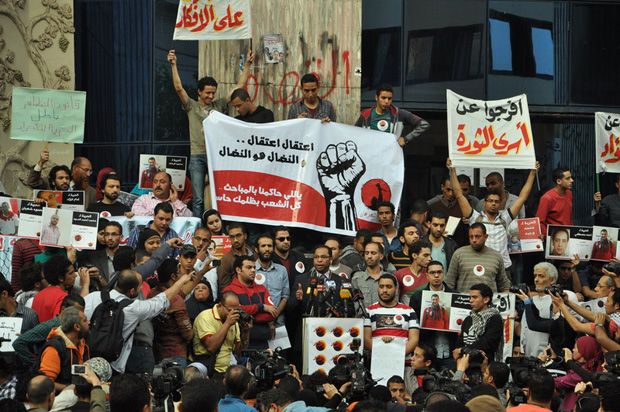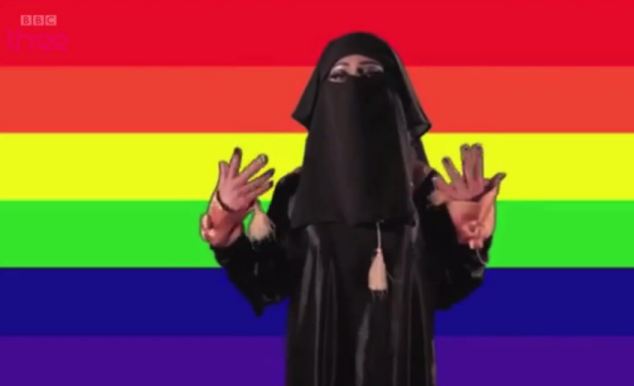Index relies entirely on the support of donors and readers to do its work.
Help us keep amplifying censored voices today.

(Photo illustration: Shutterstock)
Journalists continue to come under pressure from police and protesters in Brazil, according to a report released on 8 April. Just days after the report, two journalists were targeted by police during the forced eviction of a Rio de Janiero favela.
Attacks on journalists increased 232 percent according to the study commissioned by federal authorities. The report found that there were 41 cases of violence against media workers in 2012, rising to 136 in 2013. The report, prepared by the Council for the Defense of the Human Person (CDPH), said the rise in violence can be attributed to the mass protests that began in June 2013 against transport fare rises, corruption and the amount of money spent on preparation for the FIFA World Cup 2014.
Since 2009, Brazilian media workers have been the victims of 321 attacks involving violence. Eighteen journalists have been murdered in the same period. As a result, Brazil is among the most dangerous countries in the world to be a journalist.
The report concluded that “impunity and a lack of criminal responsibility for perpetrators of attacks on freedom of expression have contributed to the increase in violence”. It also highlighted the dangers to journalists and demonstrators from police during mass protests.
The cases of journalists Mauri Konig and Andre Caramante were referenced, both of whom received death threats for their work. Konig was forced into a two-month exile in Peru because of his coverage of illegal police activities in the Brazilian state of Parana. Konig, who has since returned to Brazil, has said he will stay away from police coverage. Caramante was also forced to leave the country and go into hiding after he and his family were the subject of threats. Caramante’s situation worsened after the publication of an article exploring the election campaign of a retired military police colonel and Sao Paulo councilman. Caramante was later fired by Folha de S. Paulo.
The most recent incidents against the press took place Friday, 11 April, when journalists were covering the forced evictions of residents from the Telerj Favela, at Rio. Journalist Bruno Amorim was roughed up by a police officer, who accused him of inciting violence through his reports. Protesters also attacked the press, setting fire to several marked media vehicles. Another reporter – O Globo’s Leonardo Barros – was ordered to leave the area or face arrest. The operation ended with more than 20 arrests and three children were injured, according to sources.
The country’s environment for freedom of expression “worsened dramatically during 2013 and the first months of 2014” according to a second report, Press Freedom in Brazil – October 2013 to March 2014, which was presented in February at Sociedade Interamericana de Imprensa.
That report found that there were 4 deaths, 66 cases of aggression, 2 cases of judicial censorship, 6 threats, 1 attack, 1 arrest and 3 cases of intimidation in Brazil during the six months it covered. “The cases of unpunished murders of journalists and other press professionals continue to be the most serious issue” facing the Brazilian media, the report warned.
The authors found what they called “cause for alarm” in the persistence of judicial censorship practised by magistrates”. The text states that it is “noteworthy that the censorship applied to the newspaper O Estado de S. Paulo on 31 July 2009 has not yet been subject to final decision”.
In an especially severe episode cited by the report, Santiago Andade – a cameraman for the Banderantes Network, died in February after being hit by a rocket. The press freedom report went on to warn that incidents like the ones that claimed the lives of Andade and three of his media colleagues could take place during the World Cup.
The report also detailed how the ANJ met with Brazil’s minister of justice Eduardo Cardozo to ask for concrete measures to halt the attacks on journalists. The minister recognised “the seriousness of the situation” and promised to take steps to create a protocol for police to use during street protests.
This article was posted on 15 April 2014 at indexoncensorship.org

(Photo: Shutterstock)
At the University of Bristol the stagnating number of female academics in multiple degree subjects has become an increasingly important and concerning issue. Over 65.4% of Bristol students, according to my March 2014 survey, perceived a noticeable imbalance of female to male lecturers. I agree. My research led me towards an obvious concern for Bristol students: gender inequality of academia in all subjects.
With The Independent reporting that 63.9% of female undergraduates are leaving universities with “good” degrees, a lack of visibility of female academics at the University of Bristol — especially in the more scientific faculties — is in stark contrast to the number of undergraduates in the same subjects. More and more articles are appearing asking “Where are the men?” seeking to discover why the gender gap of undergraduates is weighted in women’s favour, but few have even commented on the fact that women are still struggling for visibility as academics. Women are avoiding the academic world and important questions must be asked about whether this is evidence of institutional laziness on the part of universities.
A recent Commons Report titled “Women in Scientific Careers” (focussing solely on the topic of academia) found the gender diversity – or lack of it – in senior academic positions in STEM (Science, Technology, Engineering and Mathematics) “astonishing”. This conclusion of surprise is certainly supported by the Bristol experience: only 19% female Biology academics and fewer than 7% female Chemistry academics. Science students are beginning to question the gender gap at an academic level and why in 2014 it still remains an issue for women to break into STEM academia. One biology student commented: “I’m in my second term of University and I’ve yet to be taught by a woman. Representation is important and it’s worrying that female undergraduates might be less inclined to pursue an academic career.”
Universities are attempting to improve the imbalance in STEM departments with processes such as the Athena Swan awards. However, the School of Chemistry at Bristol holds a Bronze award for “promoting gender equality” despite having fewer than ten female academics in one of the largest departments at Bristol. The bar seems quite low. This doesn’t mean there isn’t a tangible appetite to tackle inequality in academia head on, it just seems that there has been little visible progression, simply supplementary reports and promises to improve.
Many female academics such as Athene Donald, professor of experimental physics at the University of Cambridge, have expressed disappointment with the Commons Report mostly due to it appearing to provide nothing more than “superficial recommendations”. I agree with Donald when she suggests more “drastic action” to tackle the current gender norms in university departments, without a vocal and aggressive protest calling for more inclusive hiring strategies. “There is a long, long way to go but all parts of the system need to be addressed if we are going to get past the stage of mere astonishment,” Donald wrote in February. We need to involve all levels of education; if women aren’t being encouraged equally at all stages of schooling then fixing the top level of academia will do little to fix the imbalance.
Personally, it’s been my experience with the history department at Bristol that has sparked this article. Why in a subject such as history with an equal amount of male and female undergraduates are there only 29% female academic staff? Having so few women lecturers in history when both genders are so equally matched at undergraduate level causes students to wonder if the higher jobs remain a boys’ club even in 2014.
Lynne H. Walling, head of pure mathematics at University of Bristol, has experienced more than her fair of sexism on her route to the top of her profession. Maths stereotypically has always been seen as a masculine pursuit and women have often been excluded or stymied in their interest. “More and more women do math, but we can hardly find female mathematicians who keep on researching the field.” She commented in interview with Somin Kim: “Only a few speakers at academic conferences are women, and sometimes none. Women feel that they don’t fit in the mathematical society and this is the hardship to continue their research.” Representation has always been a core issue. Without at least an approximation of gender equality among lecturers, female students are less like to dream to achieve. There isn’t an absence of female curiosity or intellect, there’s a lack of a platform.
But does a mismatch between women students and male lecturers actually impact free expression? At an undergraduate level the gender of their tutor seems to greatly impact female students. It becomes an issue of their future career as many women are told by those in academia that their gender is a weakness in the fight for research funding. No wonder women are half as likely to choose academia as a preferred career than men. Penelope Lockwood investigated whether the gender of career role models affected university students and she conclusively proved that women are more greatly motivated when inspired by the women in their chosen career, not the men. This is because the female students understood that their role model had surmounted and survived gender-specific challenges that they anticipate combatting in the future. They decisively empathise better with a female tutor.
Without an equal amount of female lecturers and tutors, female students are hindered in their progression through academic ladder. We need female lecturers teaching at an undergraduate level on an equal basis with men otherwise young women will continue to find the idea of achieving equal academic freedom with men in their subject simply unachievable. It’s a cyclical system: a minority of women teach, a minority of women become academics. Freedom of expression in academia involves an equal standing at all levels, and if we’re teaching equality at undergraduate level we need to clear the career path of gender obstacles for women from the grassroots up.
It’s obviously a more complex topic than can be covered in my brief assessment but the debate needs to be breached, universities need to answer questions about their hiring process and work together to close any forms of gender imbalance that still exist in higher education – including the wage gap. The statistics referred to above appear to support the conclusion that women are still experiencing sexism, especially when applying for jobs in STEM departments.
Universities would be well advised to address the issue swiftly so that the gender balance of academic, at the very least, reflects the gender balance of their undergraduates. Research support gender equality, so why aren’t universities?
This article was posted on 15 April 2014 at indexoncensorship.org

Political activists rallied in front of the Egyptian Journalists Syndicate in Cairo to demand the immediate release of detainees. (Image: Khaled Basyouny/Demotix)
Within the next few days, Egypt is expected to put into effect a new counter-terrorism law that rights groups warn could “severely erode civil liberties” and “reinstate the old police state that existed under deposed president Hosni Mubarak”.
Earlier this month, three bombs exploded outside Cairo University killing a police general. The attacks — the latest in a string of bombings targeting security forces — prompted the government to speed up review of the stricter security bill that the authorities say is necessary “to better protect citizens against the terrorist threat”. The bill contains provisions that would significantly broaden the definition of terrorism and would give police and prosecutors more power to deal with “terror suspects”. If passed, the new legislation would also allow for stricter punishment of perpetrators of “terrorist crimes”.
Skeptics meanwhile, fear that the controversial anti-terrorism law would pave the way for more repression and greater rights violations as the authorities intensify and widen their crackdown on dissent of all stripes. In an interview broadcast on Al Jazeera, Dr. Abdalla El Ashaal, an Islamist thinker and professor of international law at the American University in Cairo stressed the need for a precise definition of terrorism. He cautioned that under the new law, government critics and opponents would likely be classified as terrorists.
The proposed bill defines a terrorist act as “use of force, violence, threats or intimidation to disturb public order or endanger the safety of the society”. It also lists a wide range of activities that would be considered “terrorist crimes” including harming individuals, intimidating them , putting their lives, freedom and security at risk; harming national security, harming the environment, monuments and public property and hindering the work of the authorities, judicial bodies, houses of worship, educational institutions and diplomatic and consular missions. The bill also extends the definition of “a terrorist act” to include behaviour that “damages or harms the communications or information system, financial sector or national economy”.
Under the draft law, “establishing, organising or heading a terrorist group is punishable by death”. Leaving no ground uncovered, the draft law further stipulates a two-year jail sentence or a fine of up to LE 10,000 (Egyptian Pounds) for anyone insulting a public employee verbally or with a sign.
The “loose definition” of terrorism in the bill has drawn denunciation from Egyptian rights organisations. In a joint statement released by 20 rights groups, they warned that “absence of the rule of law and resorting to repressive security measures and exceptional laws will undermine human rights and only lead to increased acts of armed violence and terrorism”. The broad provisions in the bill also pave the way for harassment of “peaceful political opposition members, rights activists, and pro-democracy groups,” the statement added.
The anticipated issuance of the new legislation comes as revolutionary groups in Egypt become increasingly vocal in their opposition to the draconian anti-protest law passed late last year. The pro-democracy groups have in recent days organised a series of events including a weekend marathon of runners and cyclists to bring attention to the plight of “political detainees” jailed for staging “unauthorised protests”. Three liberal activists and leading figures of the January 25 uprising are among the detainees. Last week, a Cairo appeal court upheld the jailing of activists Ahmed Maher, Ahmed Douma and Mohamed Adel for three years for protesting without police permission and assaulting a police officer. In comments to Reuters, Sarah Leah Whitson, executive director for the Middle East and North Africa at Human Rights Watch criticised the verdict against the activists as “another nail in the coffin of the January 25 Revolution”.
Both the anti protest law passed in November and the counter-terrorism bill — which will likely be signed into law before the end of the week — are part of the government’s efforts to stifle political activism and silence dissent. Revolutionary activists and rights campaigners fear the draconian laws will provide legal cover to extrajudicial killings, torture in prisons and unfair trials, allowing the authorities to clamp down even harder on the opposition.
Rights activists are also cautioning that the new law “may intensify violence and terrorism in Egypt” — a country wracked by political turmoil since the unseating of Islamist President Mohamed Morsi by military-backed protests in July 2013. At least 1,400 people have been killed and thousands of Muslim Brotherhood members and supporters have been arrested in a massive security crackdown on dissent in the wake of Morsi’s ouster. Most of the deaths have occurred in violent clashes between pro-Morsi protesters and security forces in which the latter have been accused by rights organisations of using disproportionate lethal force. The Muslim Brotherhood, the Islamist group which rose to power in Egypt’s first free and fair parliamentary elections, post revolution — and from which Morsi hails — was designated as a terrorist organisation in December.
Since the ousting of Morsi in July, there has been a surge in militant attacks targeting mainly military and police forces but also, the country’s minority Christian population and tourists. Initially concentrated in the Sinai Peninsula, the terror attacks — mostly claimed by the Sinai-based jihadi group Ansar Beit Al Maqdis — have in recent months spread to other parts of the country. Over the last few weeks, Egypt has also been rocked by a wave of student protests at state-universities across the country. Clashes between student protesters and security forces using tear gas and bird shot have resulted in the deaths of several young protesters and the arrests and detention of scores of others. The students are protesting a recent court ruling allowing police to return to university campuses and are demanding the release of student-detainees .The protesters are also opposed to former Defence Minister Abdel Fattah El Sisi’s presidential bid. Field Marshal El Sisi retired from the army earlier this month and announced his candidacy in the presidential elections, scheduled to take place on 26 and 27 May. In a televised address to the nation announcing Morsi’s removal from power last summer, the former army chief had promised an inclusive government, pledging a limited role for the army in politics .
“The proposed counter terrorism bill signals a reversal of the hard-earned freedoms gained after the January 2011 uprising and will take the country back to its pre-January 25 revolutionary state,” laments Gamal Eid, the Executive Director of the Arab Network for Human Rights.
This article was posted on 14 April 2014 at indexoncensorship.org

Asif Quraishi, better known as drag queen Asifa Lahore, sits unassumingly in a TV studio. “One question I’d like to ask”, he says, “is when will it be all right to be Muslim and gay?”
The programme is Twitter-powered BBC Three debate series Free Speech, whose host Rick Edwards (of Tool Academy and, unexpectedly, Cambridge) makes Nicky Campbell seem subdued, and where no thought is too complex for 140 characters. Producers, show name notwithstanding, spiked the question from a previous edition when officials at Birmingham Central Mosque, where Free Speech filmed on March 13, “expressed deep concerns” about gay Muslims being discussed. The speed at which showrunners acquiesced, postponing the segment, speaks to a wider trend.
The first guest to comment, kufi-clad Portuguese convert Abdullah al Andalusi, calls condemning gay sex “the Islamic position” with a party leader’s certainty. It’s unsurprising: al Andalusi, who defends public segregation by gender and from whose talks women have been banned, seeks a nondemocratic “modern [Islamic] Caliphate” under sharia government, free among other things of “women wearing bikinis”, “the hijab being optional” and “men and women having identical inheritance and gender roles”. Al Andalusi rails in-studio against notions of “extremism”, declaring them a means of profiling “Muslims with orthodox beliefs”. He sees himself as holding these, and so apparently do programme-makers, since he speaks much more than Asif does.
The counter-extremist whose work he attacks, Lib Dem candidate for Hampstead Maajid Nawaz, is also in the room. (“I will speak out”, he tells the drag performer, “on your right to identify however you want.”) Nawaz too has been hounded by religious would-be censors, despite being a Muslim himself. This January, following the LSE’s attempts to ban it, he tweeted an image from the atheist web strip Jesus and Mo, commenting “This is not offensive and I’m sure God is greater than to feel threatened by it.” A subsequent Change.org petition calling for his sacking gained over 20,000 signatures, some with death threats attached. Though Nick Clegg eventually stepped in to condemn them, spokespeople told the press the party “urged all candidates to be sensitive to cultural and religious feelings”, and Nawaz – presumably after internal bickering – conceded in a joint statement with Mohammed Shafiq, head of the Ramadhan Foundation and leader of the witchhunt, that “images of the spiritual leaders of all religions should be deemed to be respectful”.
In February Shazad Iqbal, a hitherto unknown British Muslim, used a similar petition to demand YouTube remove Katy Perry’s “Dark Horse” video, in which an Ancient Egyptian turns to sand whose pendant, on close inspection, reads “Allah”. “Blasphemy is clearly conveyed in the video”, Iqbal wrote. “Such acts are not condoned nor tolerated.” While the offending necklace, which had to be indicated using photoshopped freeze-frames, was barely visible, tens of thousands of signatures poured in – today, the page boasts more than 65,000 – and Perry’s producers digitally obscured it.
Iqbal, who used his petition site to share evangelistic videos, gained a platform much like Iqbal’s and al Andalusi’s. All three, and countless more religious rightists, have sold themselves as commentators, “community leaders” and de facto spokesmen for Muslims (“men” is applicable here), grabbing the spotlight neither through skilled writing nor through views polls say are actually widespread. They owe their standing to officialdom’s mounting anxiety to please the most censorious believers, its instinct that those eagerest to cleanse the public sphere of blasphemy are those who matter most.
Recycled lines about a scaremongering anti-Muslim press over-reporting extremism come easily, but demagogues of this kind are media’s darlings; far from casting them as bogeymen, it heaps meetings with politicians, TV appearances and public validation on them. Nor is this pattern unique to Islam. In a 2012 speech for the National Secular Society, Pragna Patel of Southall Black Sisters cites the case of Behzti, a play by Gurpreet Kaur Bhatti which portrayed sexual violence in a Sikh temple. “Fundamentalists, but also so-called moderates,” says Patel, “took offence, protested and had the play removed”, theatre staff bowing to their demands. Leaders on the Sikh right, she says, stated once Bhatti entered hiding that if Labour’s Racial and Religious Hatred Act had existed at the time, it would have been used to censor the play.
Authorities sided with those attacking her, as they sided with Shafiq over Nawaz, al Andalusi and Birmingham Central Mosque over Quraishi, Iqbal over every Muslim undisturbed by Katy Perry. Reformists and minorities like them, as much as a free society, are casualties of this love for religious censors. If minor faiths, still mysteries in the public eye, need representatives, far better ones exist: A media that paints puritans and fanatics as mainstream forfeits its right to condemn them.
This article was posted on 14 April 2014 at indexoncensorship.org